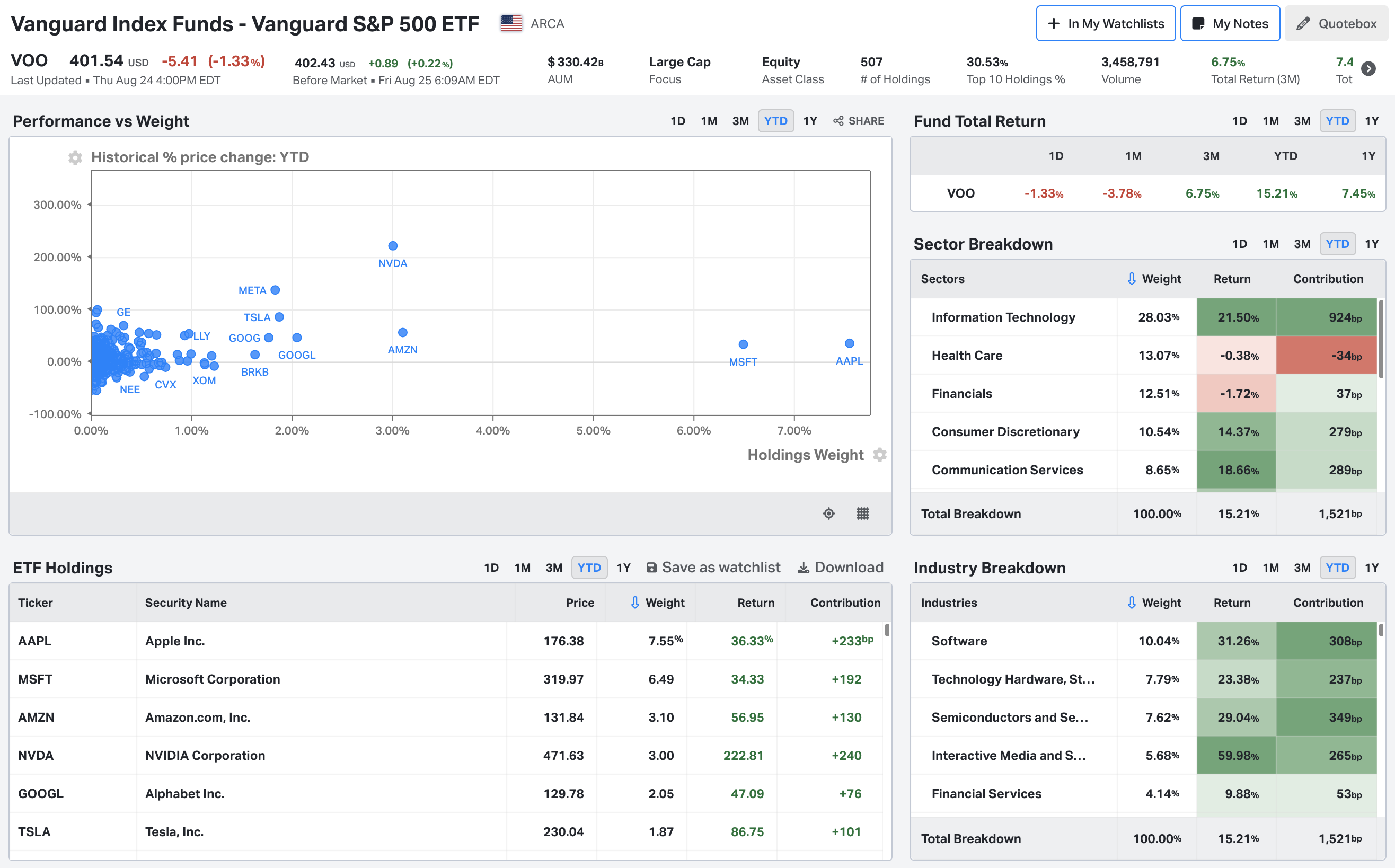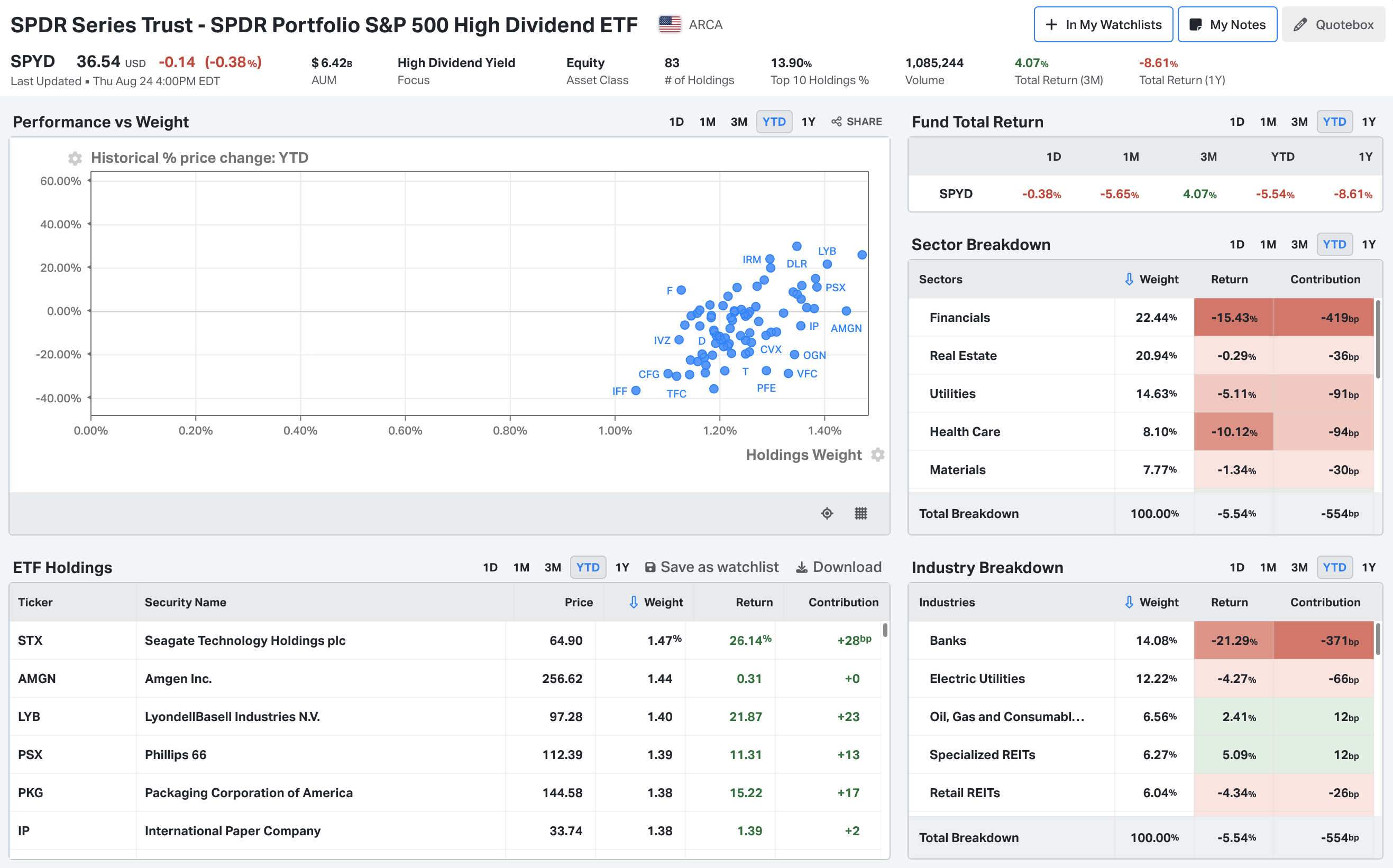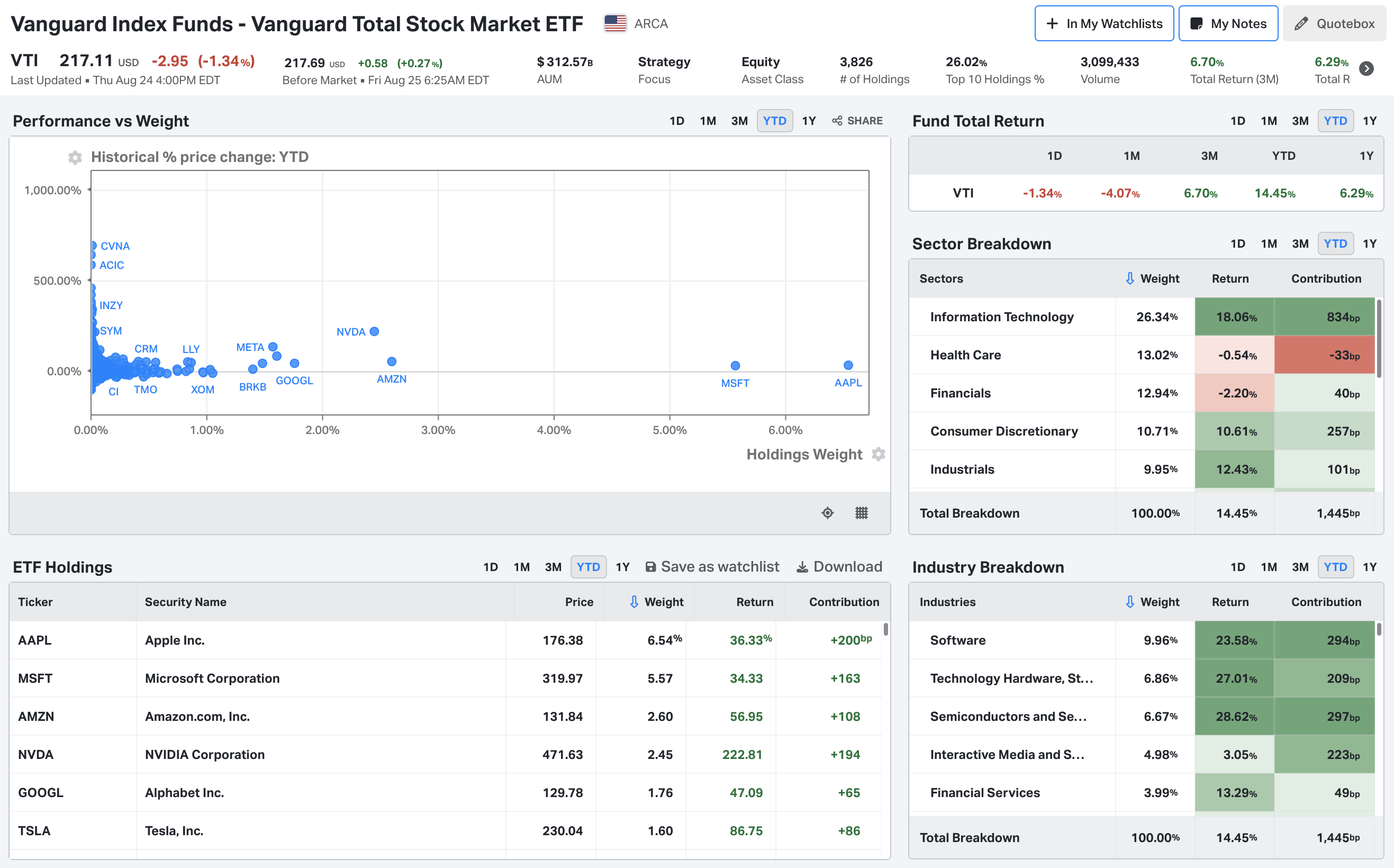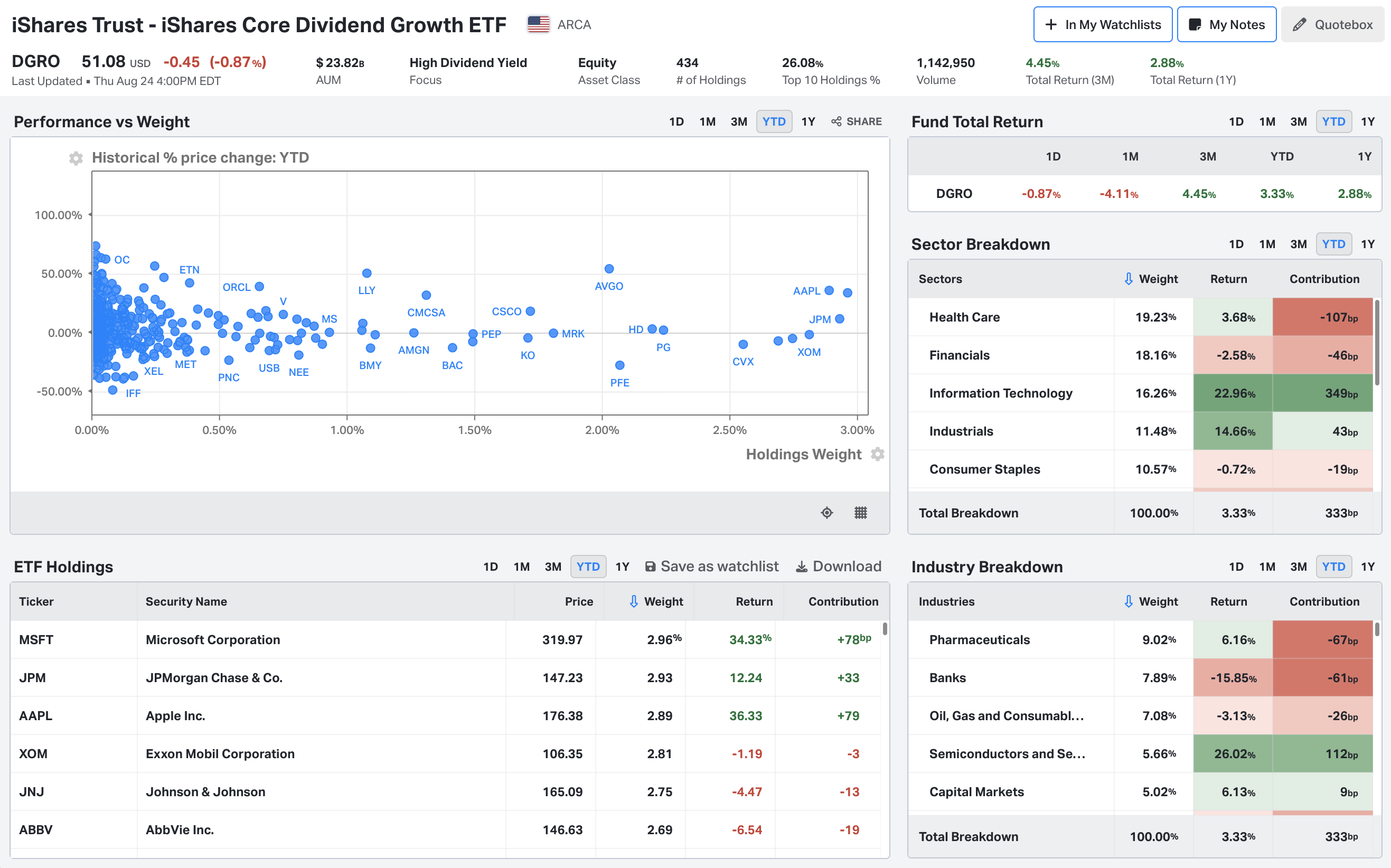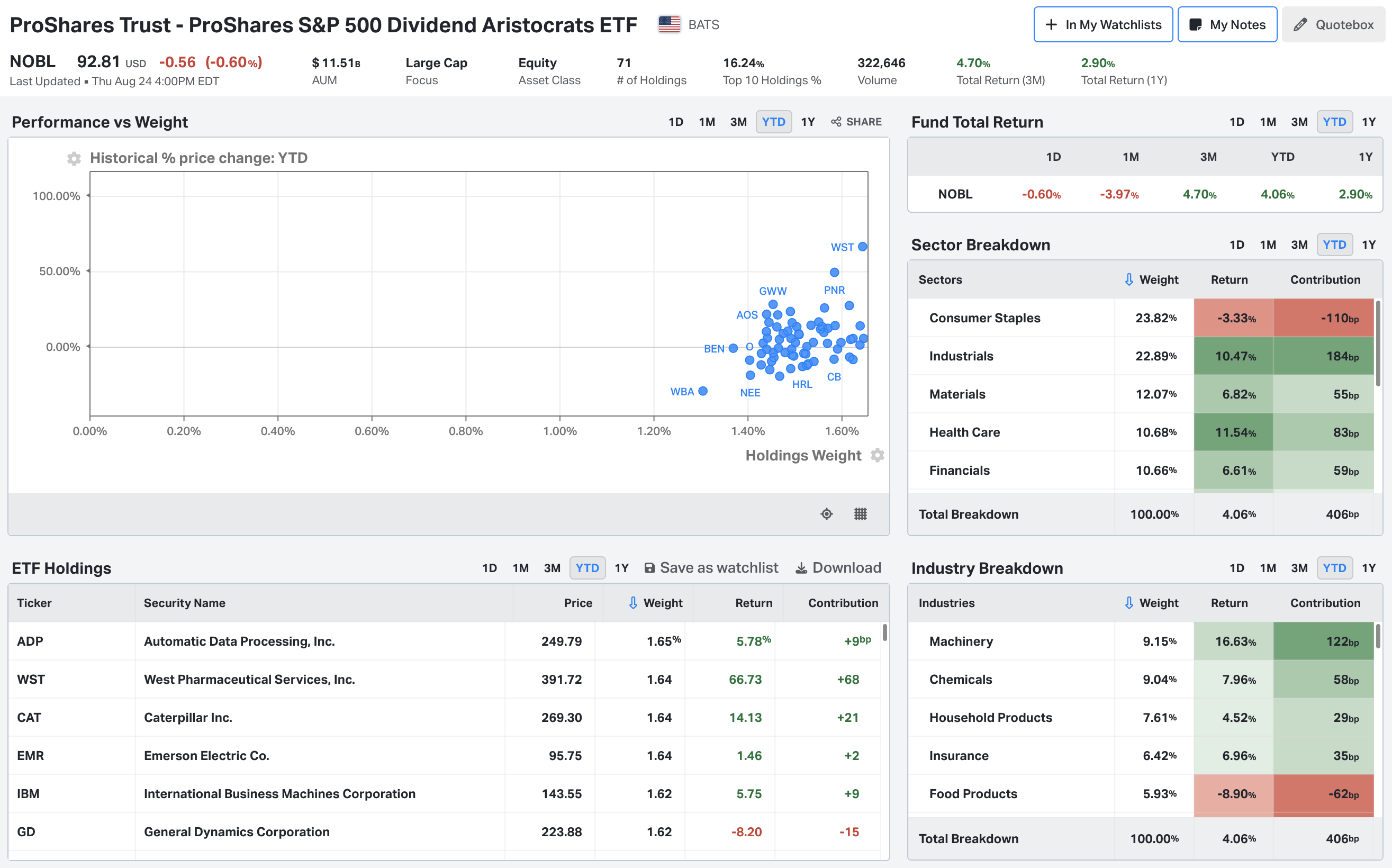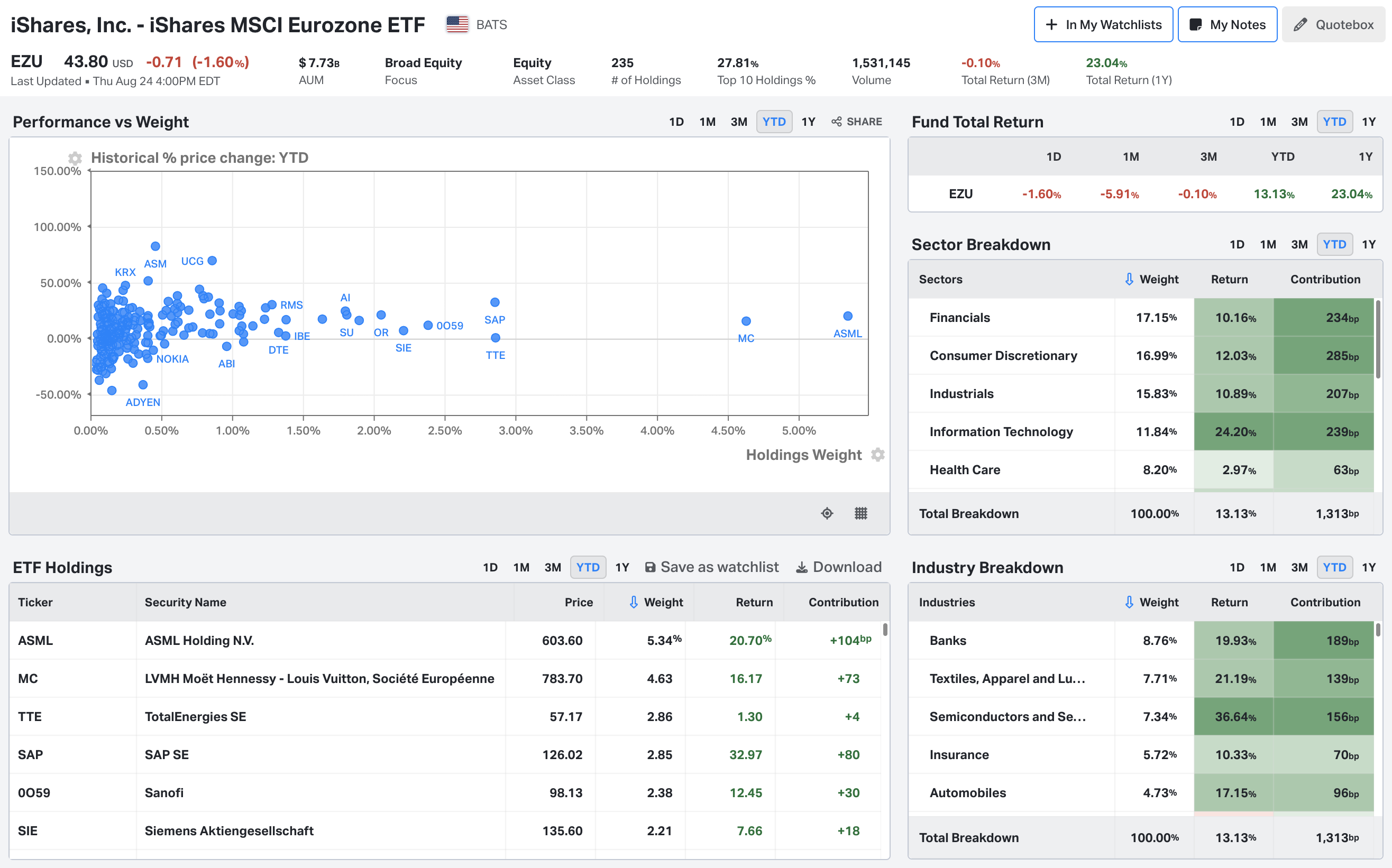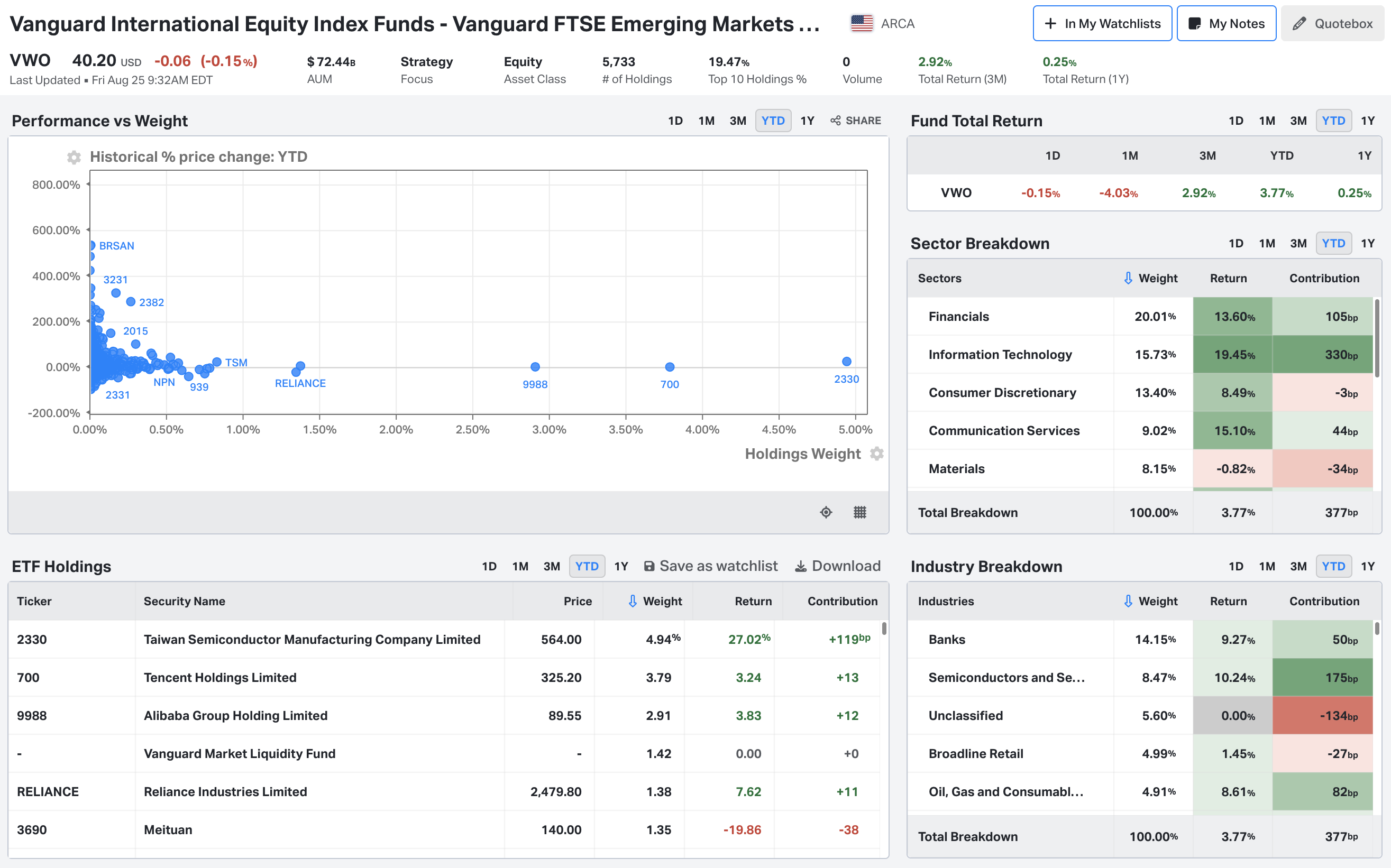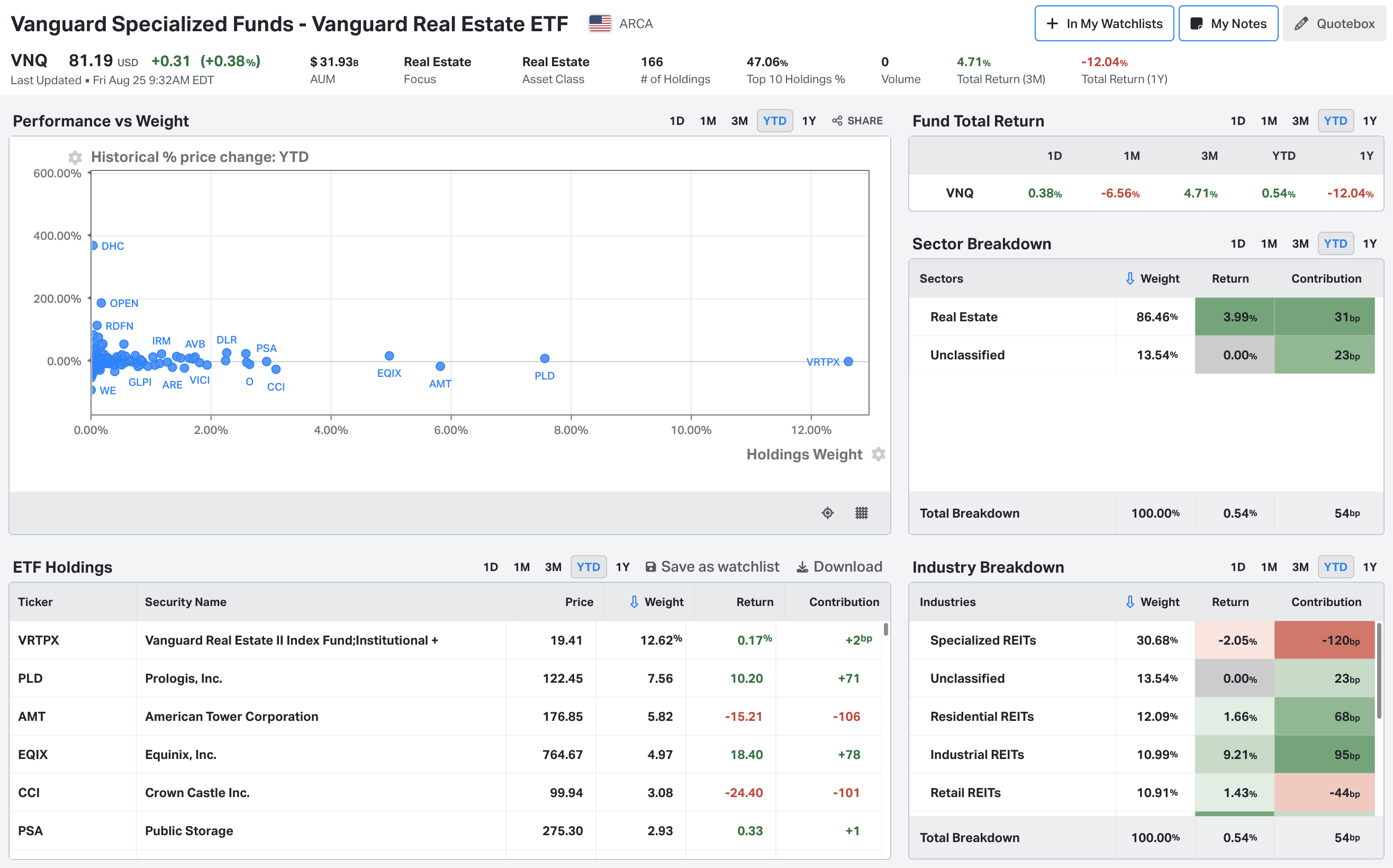8 Best Dividend ETFs of 2023: Navigating the Dividend Wave
Whether you are a young investor looking to capture the long-term benefits of compounding or someone approaching retirement and looking for steady income streams, dividend-paying companies appeal to a wide range of market participants. However, not everyone has the time or expertise to research their own basket of dividend payers, construct, and manage a portfolio.
Exchange-Traded Funds (ETFs) solve this problem by bundling an assortment of dividend-paying companies. These are diversified across exchanges, sectors, themes, and geographies, offering exposure for investors in a single, low-cost, liquid, security.
Identifying the Best Dividend ETFs: Our Strategy
It’s difficult to define what the “best” dividend ETF is because each investor has different goals and risk tolerances. In this list, we sought to identify a range of dividend ETFs that offer insight into the diversity of options available, including funds that encompass a broad range of market caps, sectors, and geographies.
Using the Koyfin ETF screener, we made our selections based on the following criteria:
- Low Cost: Five of the eight funds chosen have expense ratios below 0.1%.
- Attractive yield: We selected a variety of funds that provide either high yields or those with lower yields but with the opportunity for capital appreciation.
- No use of leverage: None of the funds in this list are levered.
- Not actively managed: All the funds in this list are passive ETFs.
- Focused on equities: This list features no fixed-income or alternative asset classes.
Discover how to find top Dividend ETFs on your own using a screener at the end of the article!
The 8 Best Dividend ETFs of 2023
Name | Ticker | Dividend Yield | Expense Ratio |
|---|---|---|---|
Vanguard S&P 500 ETF | VOO | 1.48% | 0.03% |
SPDR Portfolio S&P 500 High Dividend ETF | SPYD | 4.87% | 0.07% |
Vanguard Total Stock Market ETF | VTI | 1.47% | 0.03% |
iShares Core Dividend Growth ETF | DGRO | 2.41% | 0.08% |
Proshares S&P 500 Dividend Aristocrats ETF | NOBL | 1.96% | 0.35% |
iShares MSCI Eurozone ETF | EZU | 4.49% | 0.52% |
Vanguard FTSE Emerging Markets ETF | VWO | 3.59% | 0.08% |
Vanguard Real Estate ETF | VNQ | 3.99% | 0.12% |
*Data as of August 25th, 2023
Ready to monitor these funds closely? Keep scrolling to the end of the article to uncover simple tips for creating your own watchlist!
Vanguard S&P 500 ETF (VOO)
Starting off nice and simple, the Vanguard S&P 500 ETF (VOO) tracks the constituents and the performance of the S&P 500 index. Past results are not indicative of future returns, but the S&P 500 is one of the most well-known indices in the world. It’s comprised of companies that span the globe and has been a mainstay in investors’ portfolios for decades. The S&P 500 is the benchmark against which most investors track their own performance, and given how hard it is to actually beat the market, why not simply buy the market?
VOO currently offers investors exposure to 507 companies within the S&P 500, where the largest sectors by market cap weighting are technology (28%), healthcare (13%), financials (12%), consumer discretionary (11%), and communication services (9%). This comes with an incredibly low expense ratio of 0.03%. The top 10 companies make up 30.5% of the weighting in this ETF, the second most concentrated in our list, and include technology heavy-hitters like Apple, Microsoft, Amazon, Nvidia, Alphabet, Tesla, and Meta. Because of the ETF’s high concentration of technology companies, the dividend yield on offer, 1.48%, is one of the lowest on the list. However, what it lacks in dividend return, it more than makes up for in total return. From Jan 1st, 2011 to Jan 1st, 2023, VOO returned 11.75% compounded annually, giving investors both income and capital appreciation opportunities.
Key Investment Insights for Vanguard S&P 500 ETF (VOO):
Focus:
Large Cap
Benchmark:
S&P 500 Index
Number of Holdings:
507
Top 10 Weight:
30.53%
AUM:
$330.4 billion
Expense Ratio:
0.03%
Dividend Yield:
1.48%
SPDR Portfolio S&P 500 High Dividend ETF (SPYD)
The S&P 500 ETF, VOO, tracks the S&P 500, including companies that don’t pay dividends. The SPDR S&P 500 High Dividend ETF, which has 83 holdings, tracks only those within the S&P 500 that pay high dividend yields. This ETF has a slightly higher expense ratio of 0.07% but offers investors a considerably higher dividend yield of 4.87%.
Because this ETF tracks only the highest dividend payers within the S&P 500, the sectoral composition is largely made up of financials (22%), real estate (21%), utilities (15%), health care (8%), and materials (8%). There’s a noticeable diminished influence from technology stocks compared to VOO, as those companies often don’t pay dividends, and when they do, they tend to offer a low yield. As a result, notable technology dividend payers like Apple, Visa, Mastercard, and Microsoft are not constituents of this ETF.
History has shown that SPYD, and similar ETFs that track high-yield S&P 500 companies, underperform traditional S&P 500 ETFs over time in terms of total return. However, this ETF might be suitable for investors who prioritize income streams.
Key Investment Insights for SPDR Portfolio S&P 500 High Dividend ETF (SPYD):
Focus:
High Dividend Yield
Benchmark:
S&P 500 High Dividend Index
Number of Holdings:
83
Top 10 Weight:
14.06%
AUM:
$6.4 billion
Expense Ratio:
0.07%
Dividend Yield:
4.87%
Vanguard Total Stock Market ETF (VTI)
Similar to VOO, the Vanguard Total Stock Market ETF (VTI) tracks companies that both offer and don’t offer dividends to shareholders. The difference is that VTI tracks companies across a broader spectrum of US markets, holding more than 3,800 stocks. This ETF includes large caps as well as small and mid-cap companies. VTI offers an identical expense ratio (0.03%) to VOO with a similar yield of 1.47%.
The sectoral composition is also similar: it’s largely concentrated in technology (26%), healthcare (13%), and financials (13%). While the top 10 companies also look similar to VOO, the concentration of these companies in relation to the ETF as a whole is lower, at 26%. VTI may be an ideal ETF for investors who want to capture the returns from the entirety of the US market, and not just the S&P 500.
Key Investment Insights for Vanguard Total Stock Market ETF (VTI):
Focus:
Broad Equity
Benchmark:
CRSP US Total Market Index
Number of Holdings:
3,826
Top 10 Weight:
26.02%
AUM:
$312.6 billion
Expense Ratio:
0.03%
Dividend Yield:
1.47%
iShares Core Dividend Growth ETF (DGRO)
The iShares Core Dividend Growth ETF, DGRO, is similar to SPYD in that it tracks companies paying dividends. The difference is that DGRO covers a wider spectrum of the US market with 433 holdings and is focused on companies that not only pay dividends but also grow their dividends over time. This means DGRO includes companies with lower yields, as demonstrated by the fund’s higher exposure to the technology sector. In all, the sectoral composition is concentrated in health care (20%), financials (18%), technology (16%), industrials (12%), and consumer staples (10%).
With an expense ratio of 0.08%, DGRO offers a modest yield of 2.4% and includes larger technology companies such as Apple, Microsoft, and Visa, despite their lower yields. When investing in dividend-paying companies, caution must be exercised when observing yields. Although a company may offer a high yield, it’s essential to understand the company’s ability to continue paying and growing their dividend over time. For instance, while a company like Apple pays a relatively low dividend yield, they possess the balance sheet strength to grow the dividend comfortably over time.
Key Investment Insights for iShares Core Dividend Growth ETF (DGRO):
Focus:
High Dividend Yield
Benchmark:
Morningstar US Dividend Growth Index
Number of Holdings:
433
Top 10 Weight:
26.34%
AUM:
$23.8 billion
Expense Ratio:
0.08%
Dividend Yield:
2.41%
Proshares S&P 500 Dividend Aristocrats ETF (NOBL)
NOBL is an ETF that screens for multinational companies that have increased their dividends consecutively for at least 25 years, earning them the title of ‘dividend aristocrat.’ Some of these companies have maintained this streak for over 45 years. With only 71 holdings, NOBL has the smallest basket of companies of any dividend ETF on this list. It offers a yield of 1.96% and has an expense ratio of 0.35%.
Key Investment Insights for Proshares S&P 500 Dividend Aristocrats ETF (NOBL):
Focus:
Large Cap
Benchmark:
S&P 500 Dividend Aristocrats Index
Number of Holdings:
71
Top 10 Weight:
16.27%
AUM:
$11.5 billion
Expense Ratio:
0.35%
Dividend Yield:
1.96%
iShares MSCI Eurozone ETF (EZU)
The iShares MSCI Eurozone ETF, EZU, tracks equities across the Eurozone region and offers the second-highest yield, 4.49%, on our list. Interestingly, this high yield comes despite the ETF not explicitly focusing on dividend-paying companies. This can be attributed to the general tendency of European companies to pay dividends but also to the ETF’s concentration in financials (17%), consumer discretionary (17%), industrials (16%), technology (12%), and healthcare (8%).
This ETF is ideal for investors desiring exposure to some of the EU’s highest-quality companies. However, investors should note that this fund has the highest expense ratio on our list, at 0.52%.
Key Investment Insights for iShares MSCI Eurozone ETF (EZU):
Focus:
Broad Equity
Benchmark:
MSCU EMU Index
Number of Holdings:
235
Top 10 Weight:
27.65%
AUM:
$7.7 billion
Expense Ratio:
0.52%
Dividend Yield:
4.49%
Vanguard FTSE Emerging Markets ETF (VWO)
For investors who want international exposure and an attractive dividend yield but at a lower cost, the Vanguard Emerging Markets ETF might be for you. At an expense ratio of 0.08% and a yield of 3.59%, VWO comprises more than 5,700 holdings and invests in stocks of companies located in emerging markets around the world, such as China, Brazil, Taiwan, and South Africa. Explore more emerging market ETF options in our best emerging market ETFs article.
Key Investment Insights for Vanguard FTSE Emerging Markets ETF (VWO):
Focus:
Strategy
Benchmark:
FTSE EM All Cap China Inclusion Index
Number of Holdings:
5,733
Top 10 Weight:
19.47%
AUM:
$72.4 billion
Expense Ratio:
0.08%
Dividend Yield:
3.59%
Vanguard Real Estate ETF (VNQ)
The Vanguard Real Estate ETF, VNQ, is a specialized fund that invests solely in real estate-related equities known as real estate investment trusts (REITs). This encompasses specialized, residential, industrial, and retail REITs. A REIT is a company that owns, and in most cases operates, a portfolio of income-producing real estate. The fund has an expense ratio of 0.12% and an attractive dividend yield of 3.99%.
In a similar way that dividend ETFs remove the burden of researching, constructing, and managing a portfolio of dividend-paying stocks, VNQ provides investors with diversified exposure to the US real estate market, boasting 166 holdings and an appealing income stream.
Key Investment Insights for Vanguard Real Estate ETF (VNQ):
Focus:
Real Estate
Benchmark:
MSCI US Investable Market Real Estate 25/50 Index
Number of Holdings:
166
Top 10 Weight:
47.06%
AUM:
$31.9 billion
Expense Ratio:
0.12%
Dividend Yield:
3.99%
How To Find Top Dividend ETFs
Step 1: Sign Up to Koyfin for Free. Register an account and get started; no credit card required.
Step 2: Create a Screener. Head to ‘My Screens’, create a new ETF screener and give it a name.
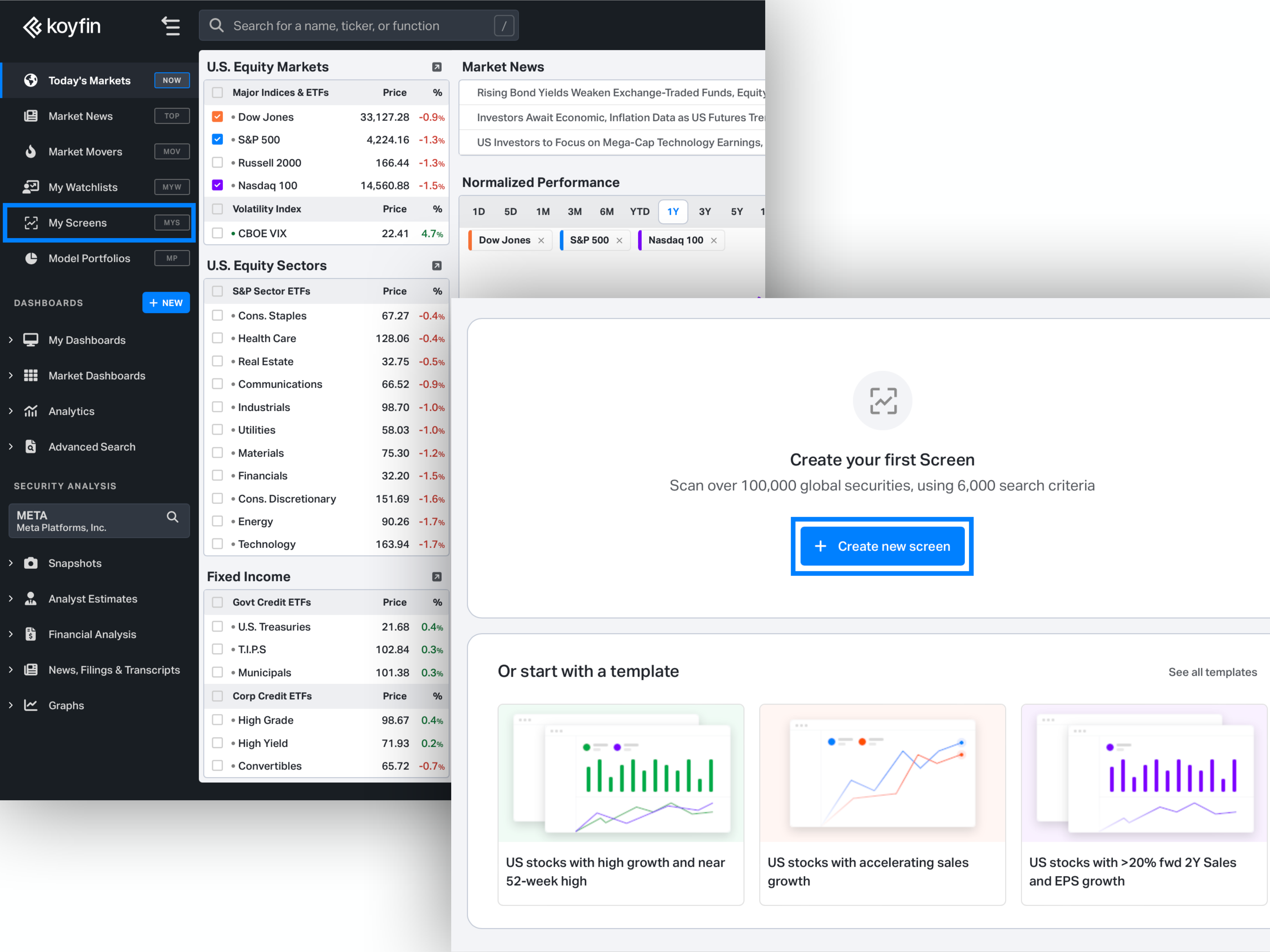
Step 3: Define your Investment Universe. Select a trading region, or multiple regions, and your desired countries. Select the asset class for equity.
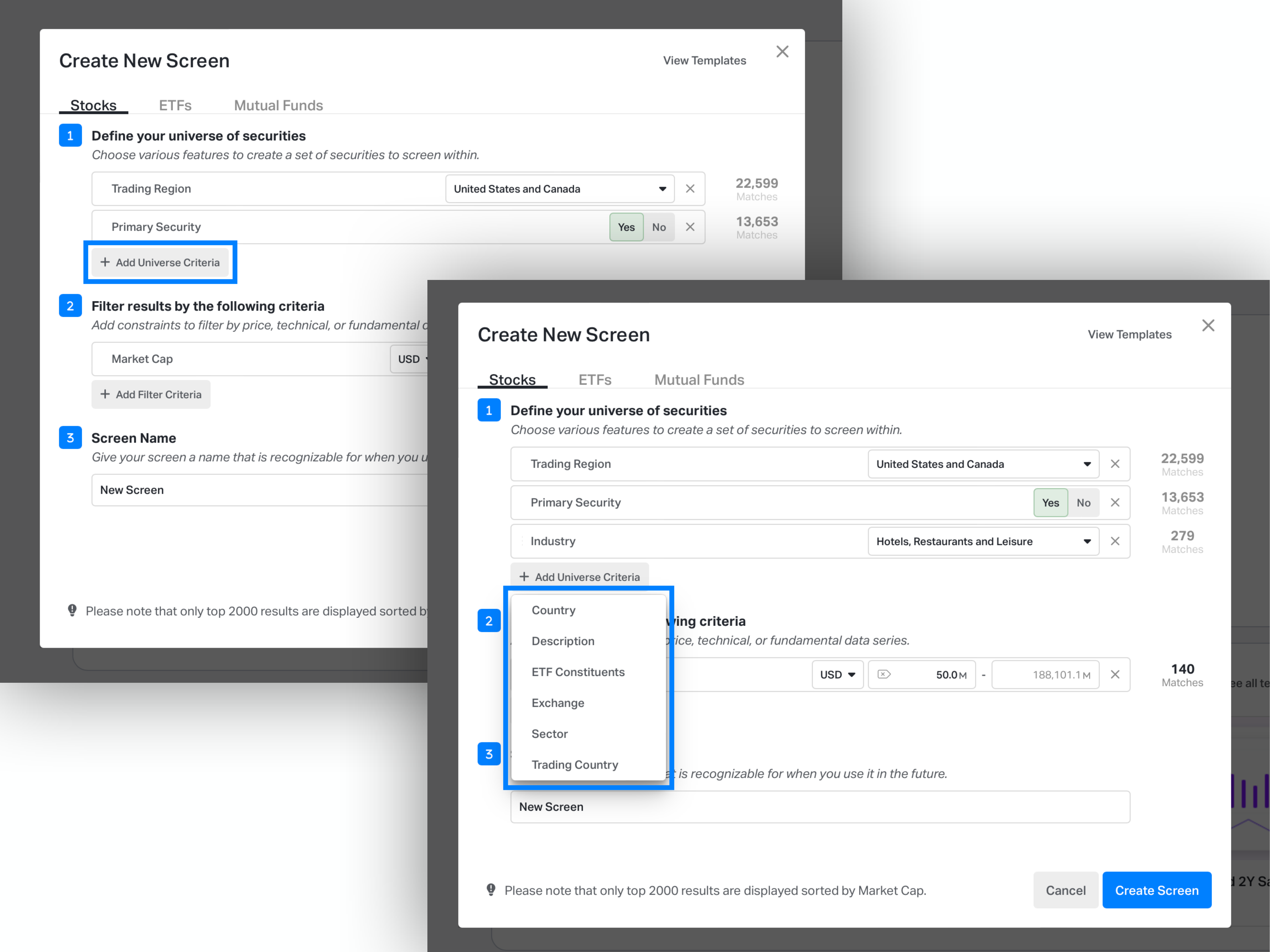
Step 4: Add Filter Criteria. We have thousands of data points you can add to a screener. For a top dividend ETF screener, we recommend the following criteria, but you can make your own too:
- Dividend Yield: Add the desired range
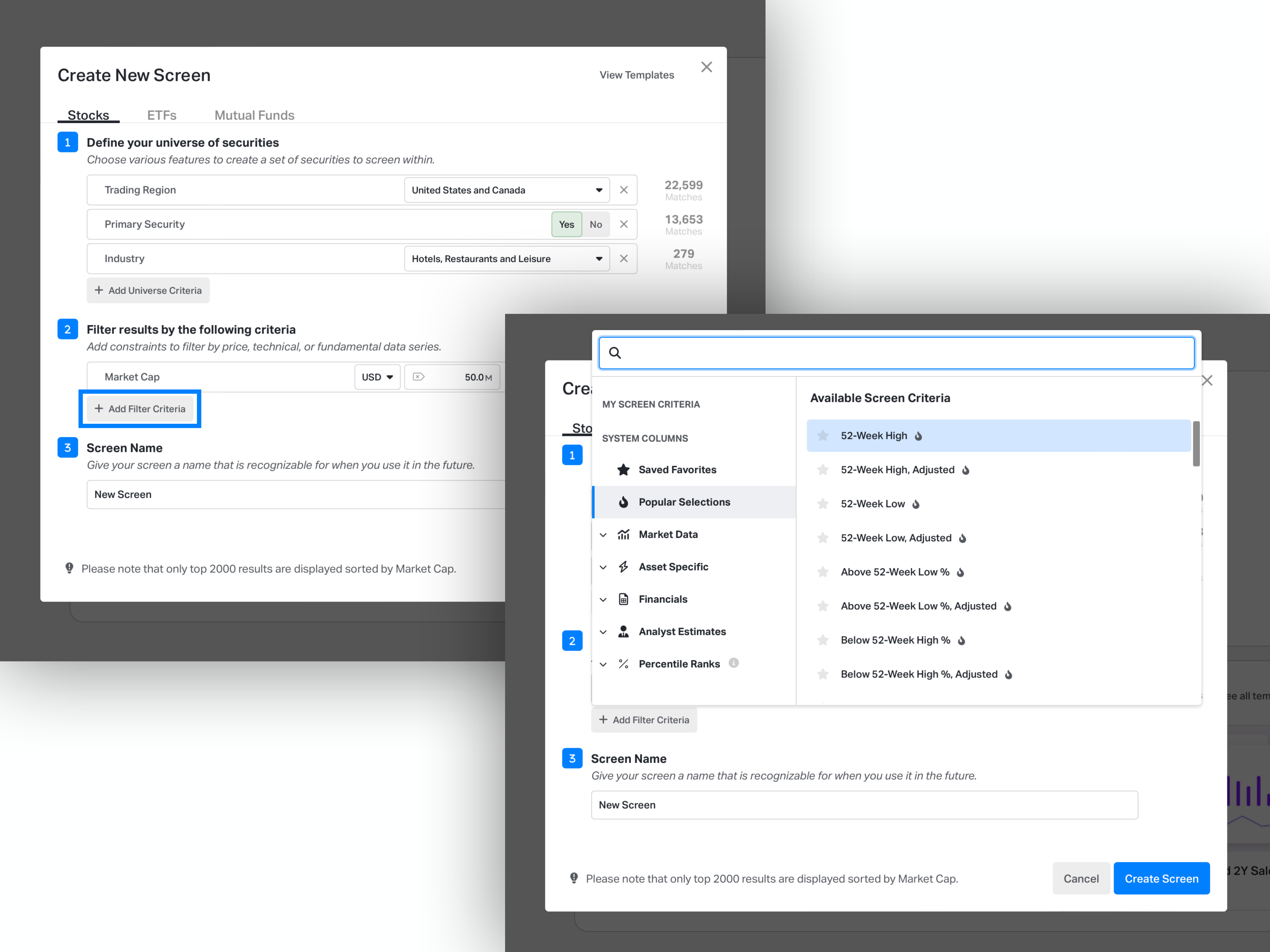
Step 5: Create Screen. When you are happy with your screener, give it a name, hit save and apply. You can also save this screener output as a watchlist too, and add columns like expense ratio, aum, and more ETF-specific items.
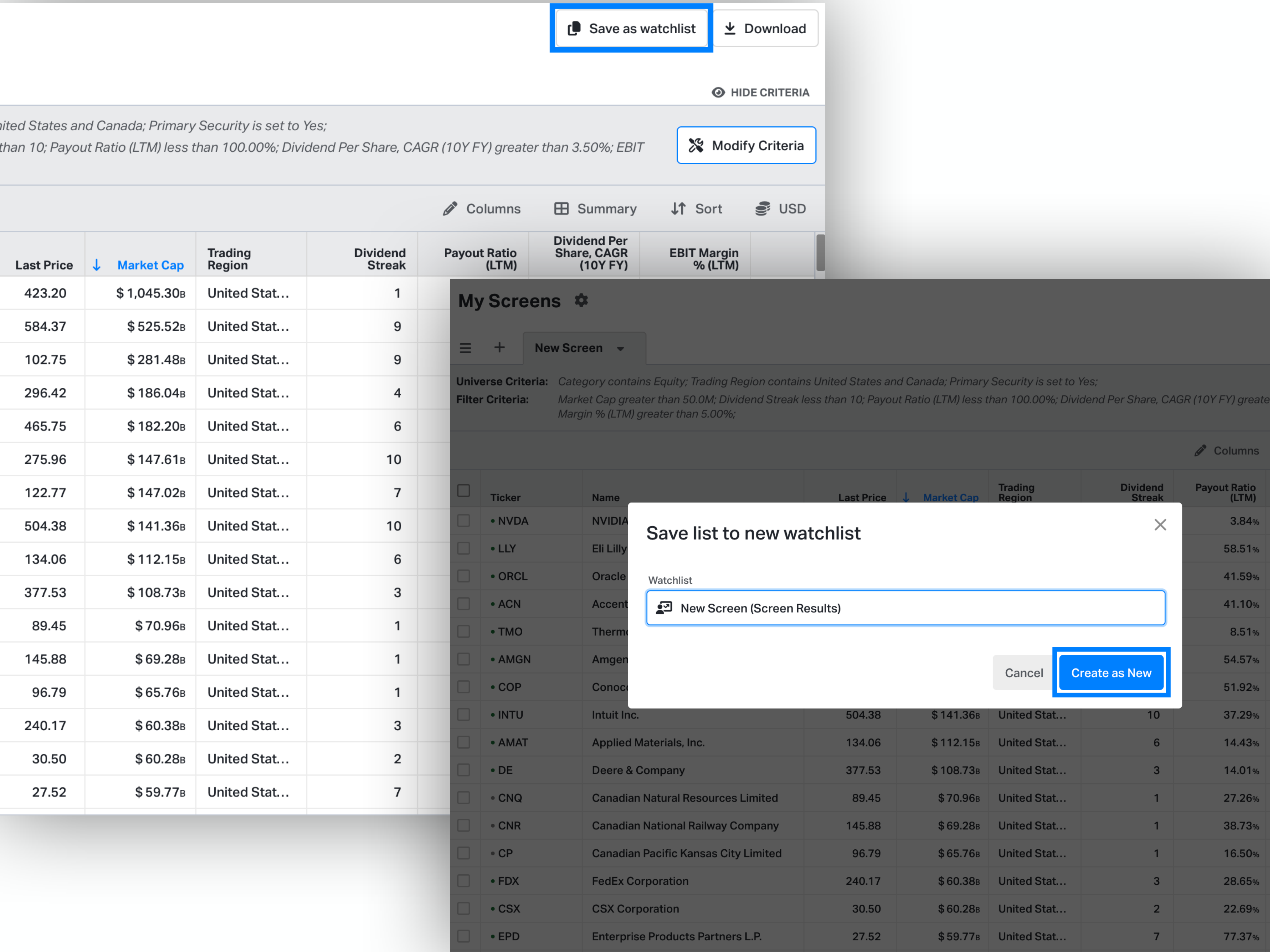
How to Create a Watchlist for Top Dividend ETFs
Step 1: Sign Up to Koyfin for Free. Register an account and get started; no credit card required.
Step 2: Create a Watchlist. Head to ‘My Watchlists’, create a new watchlist and give it a name.
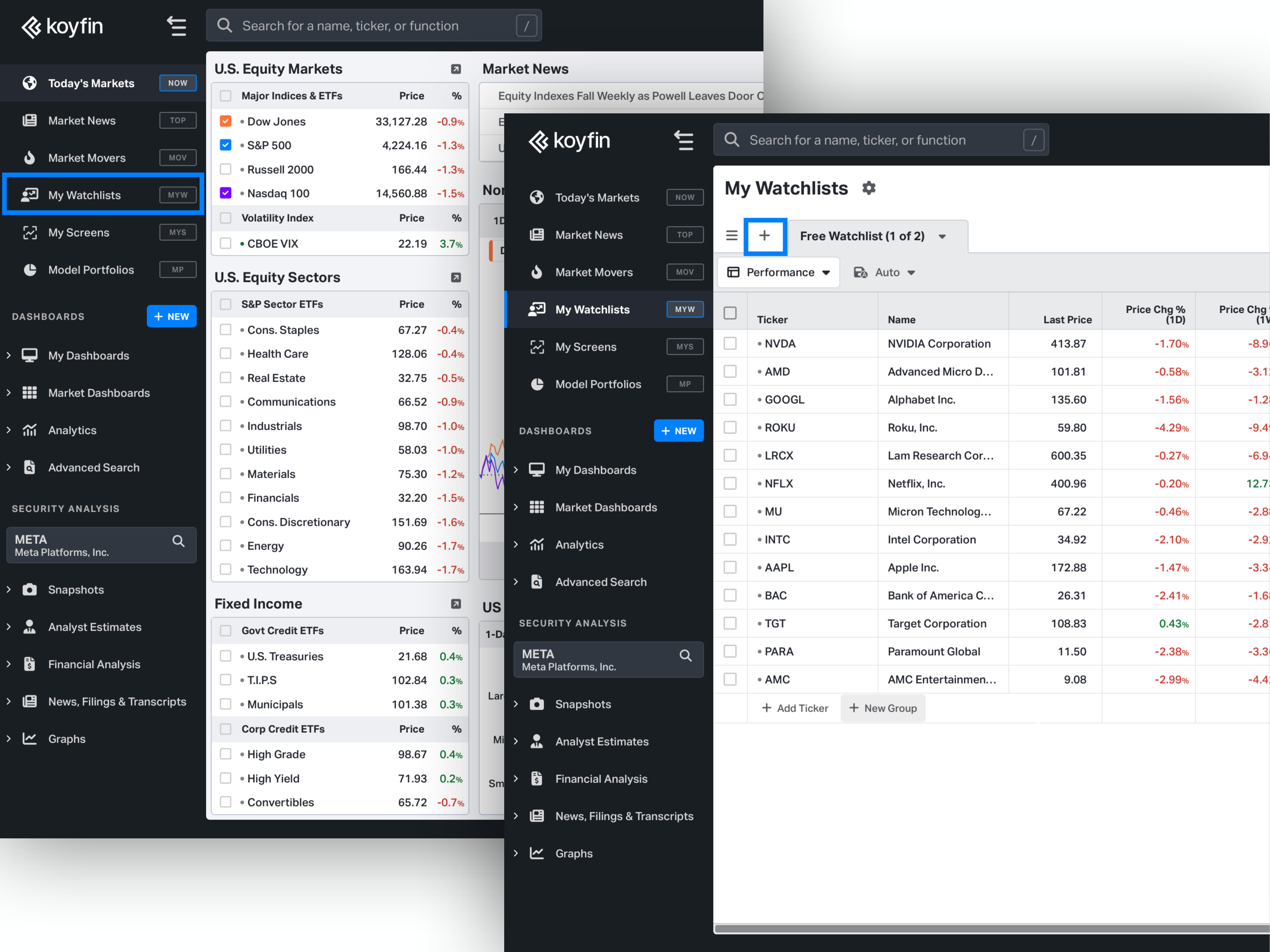
Step 3: Add Tickers. Click ‘Add Ticker’, then ‘Import Securities’, then copy and paste the below list of tickers.
VOO, SPYD, VTI, DGRO, NOBL, EZU, VWO, VNQ
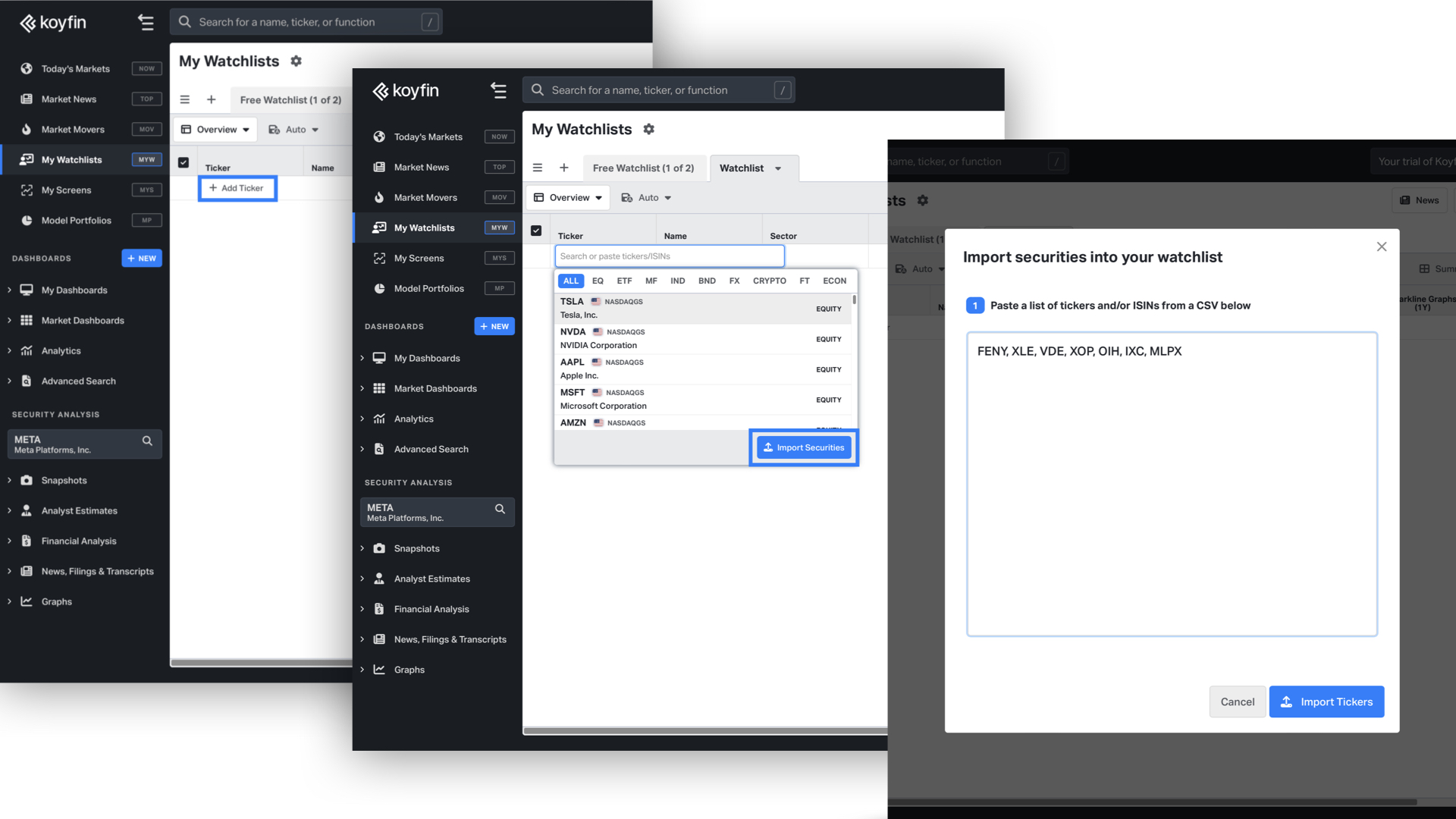
Step 4: Customize Columns. Hit the ‘Columns’ icon to add and remove columns from your watchlist table.
We have thousands of data points you can add to a watchlist, including fundamental data, price and returns data, analyst estimates, percentile ranks, security information, portfolio tools, and the ability to create your own formulas and labels.
Now your watchlist is ready, and you can use the rest of the Koyfin terminal to track and analyze these ETFs.
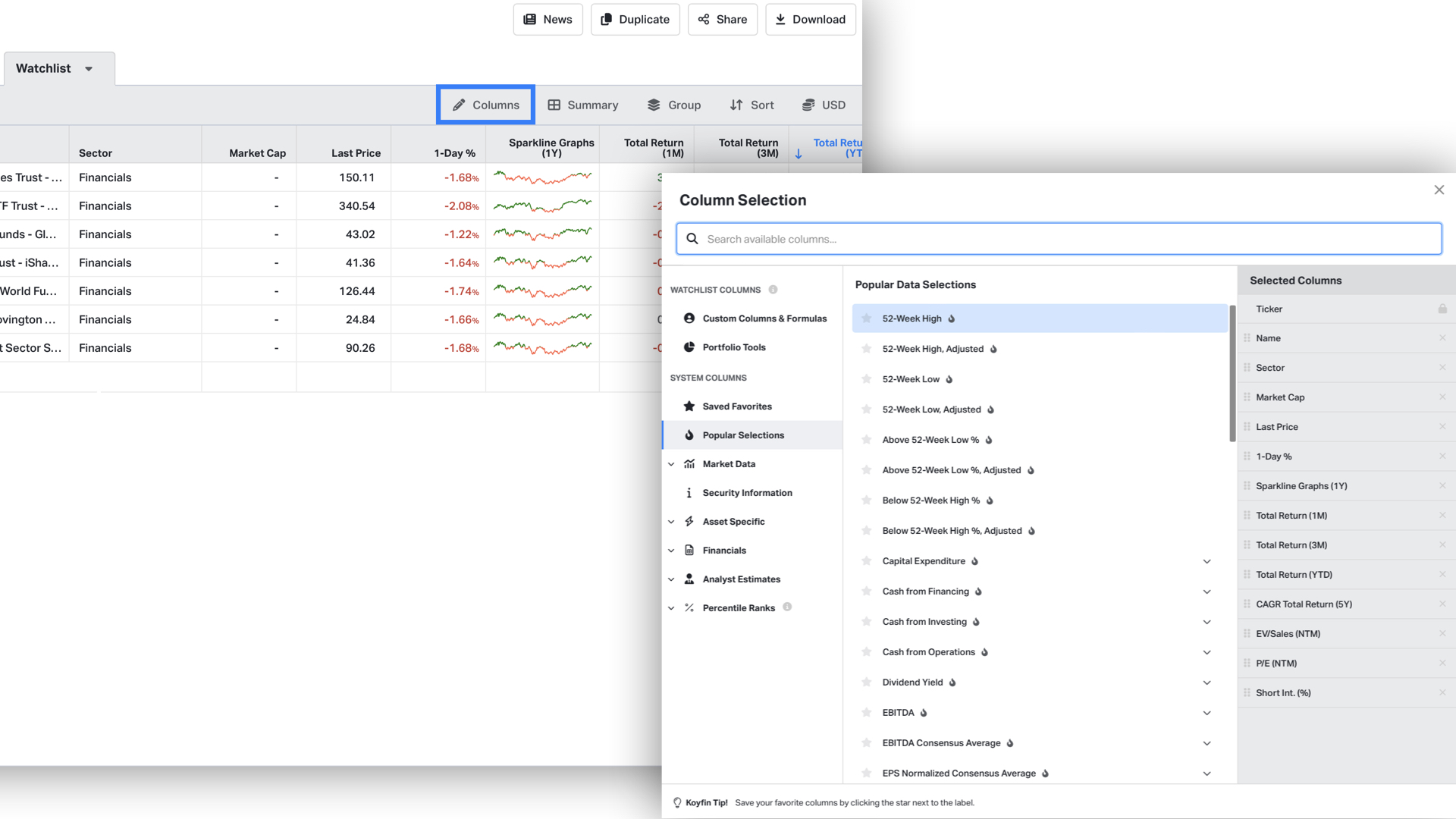
FAQ
-
What is a dividend?
A dividend is a payment made by a corporation to its shareholders, usually in the form of cash or additional shares. It represents a portion of the company’s earnings distributed to stockholders.
-
Why do companies pay dividends?
Companies pay dividends to distribute a part of their profits back to shareholders. Dividends can serve as an incentive for investors to buy or hold the stock and reflect the company’s financial health and profitability.
-
How do I reinvest a dividend?
To reinvest a dividend, you can enroll in a Dividend Reinvestment Plan (DRIP). DRIPs automatically use your dividends to purchase more shares of the stock or ETF that paid the dividend, often without any commission charges. Alternatively, you can manually choose to reinvest the dividend back into the same company.
-
What is an exchange-traded fund?
An exchange-traded fund (ETF) is a type of investment fund that holds a collection of assets, such as stocks, bonds, or commodities, and is traded on stock exchanges similar to individual stocks. ETFs provide a way for investors to diversify their portfolios without buying each individual asset.
-
What іs a Dividend ETF?
A Dividend ETF is an exchange-traded fund that focuses on investing in stocks that pay dividends. The aim is to generate income from the dividends as well as potential capital appreciation.
-
Types of Dividend ETFs
High Dividend Yield ETFs: Focus on stocks with a higher-than-average dividend yield.
Dividend Growth ETFs: Concentrate on companies that have a history of consistently increasing their dividends.
Sector-specific Dividend ETFs: Invest in dividend-paying stocks within a specific sector, such as utilities or real estate.
International Dividend ETFs: Focus on dividend-paying companies located outside of the investor’s home country.
Editorial note
Our insights are derived solely from historical information and analyst predictions, employing an impartial approach. Please note that our articles do not serve as financial guidance.

